The Milwaukee Public Museum houses one of the largest Dogrib collections in the United States. The first item came to the Museum in 1941 through Keith Gebhardt, an employee of the museum. Dr. Nancy Oestreich Lurie donated much of the current collection in 1967 and 2000. June Helm's husband, Pierce King, donated several items to the museum collection in 2005, after Helm's passing in 2004. Lyle Shannon also donated an item that had been collected by June Helm.
Much of the 70-piece collection includes utilitarian items, such as household tools and clothing items, but there are also several hand drums and games.
Clothing
High quality warm clothing was important to the Dogrib, as the area in which they lived could be brutally cold during much of the year. Many items in this collection are constructed with tanned caribou or moose hide. Some items are intricately decorated with hand embroidery using moose hair or silk thread, and/or have detailed glass beadwork. Several pairs of moccasins and gloves have beaver or caribou fur trim, calico lining, and red stroud heel trim. The high cuffs and ties on several pairs of moccasins would aid in keeping legs warm as well as keeping snow out. The commercial-made parka pictured in the collection is decorated with panels of intricate hand embroidered silk thread with wool fringe about the neckline.
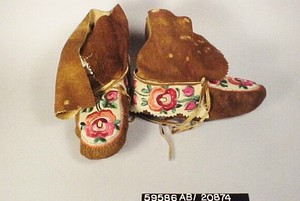
Moccasins, Fort Rae, Canada
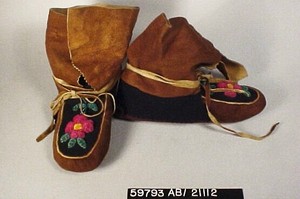
Slipper Moccasins, Fort Rae, Canada
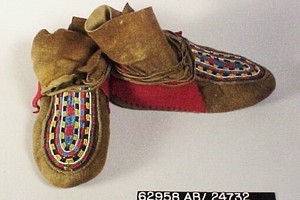
Moccasins, Fort Rae, Canada
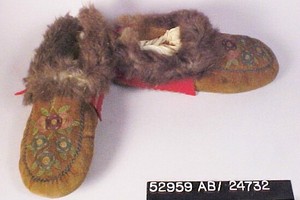
Moccasins, Lac la Martre, Canada
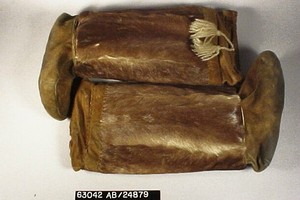
Boots, Yellowknife, Canada
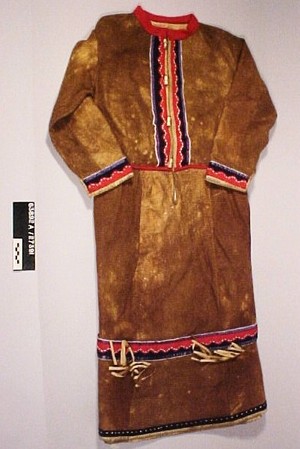
Dress, Fort Rae, Canada
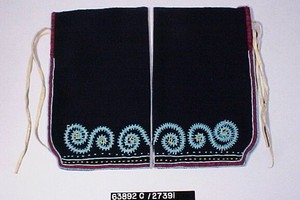
Leggings, Fort Rae, Canada
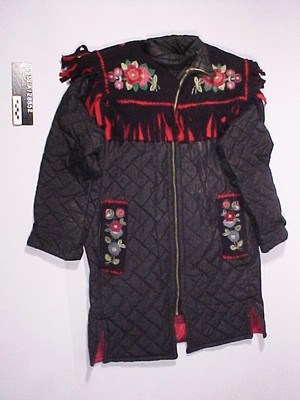
Parka, Northwest Territory, Canada
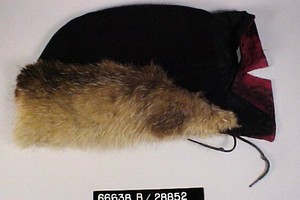
Parka Hood, Northwest Territory, Canada
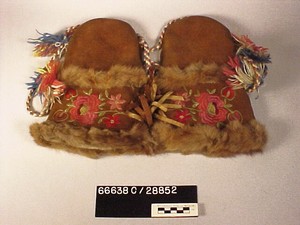
Mittens, Northwest Territory, Canada
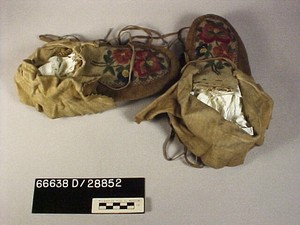
Moccasins, Northwest Territory, Canada
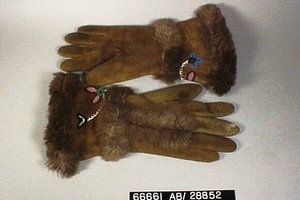
Caribou Skin Gloves, Canada
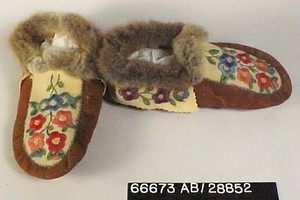
Moccasins, Northwest Territory, Canada
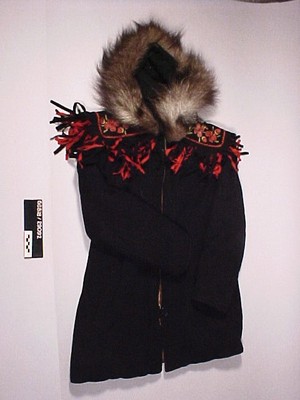
Black Wool Parka, Canada
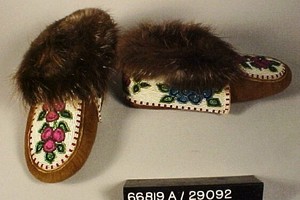
Moccasins, Canada
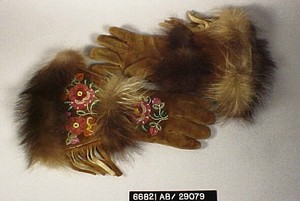
Gloves, Canada
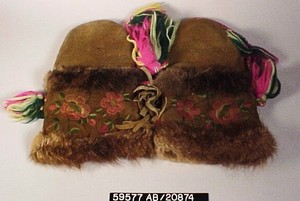
Men's Sled Mittens, Fort Rae, Canada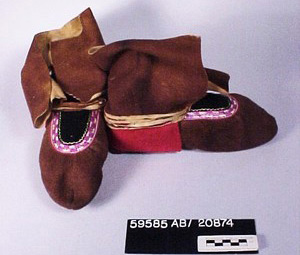
Moccasins, Fort Rae, Canada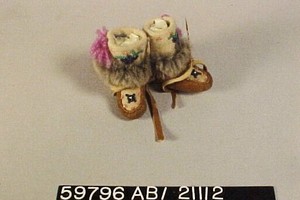
Miniature Mukluks, Fort Rae, Canada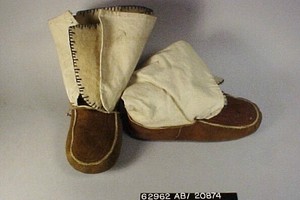
Moccasins, Fort Rae, Canada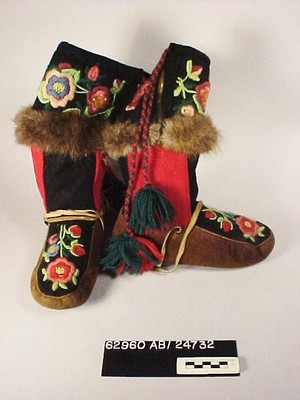
Moccasins, Lac la Martre, Canada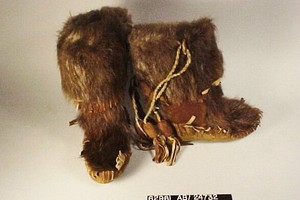
Moccasins, Fort Rae, Canada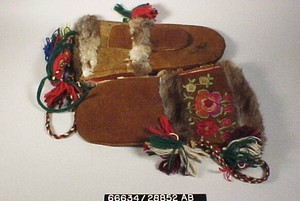
Men's Sled Mittens, Northwest Territory, Canada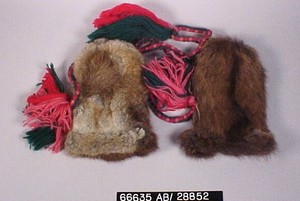
Mittens, Canada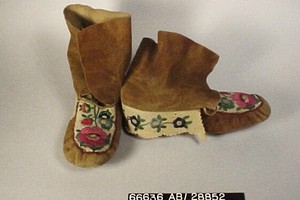
Moccasins, Canada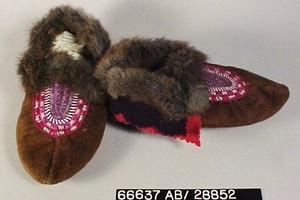
Women's Moccasins, Canada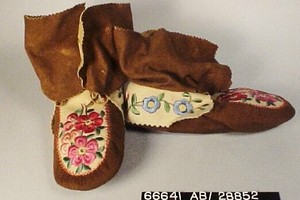
Moccasins, Canada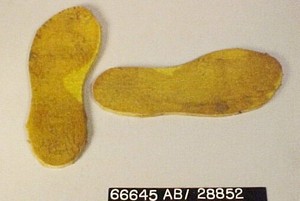
Foam Rubber Moccasin Liners, Canada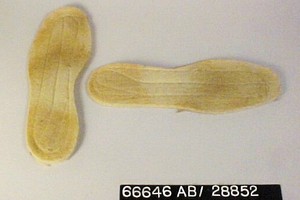
Thick Felt Moccasins Liners, Canada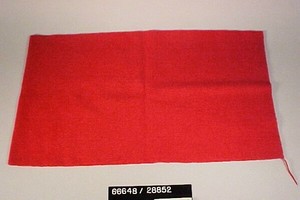
Red Stroud, Canada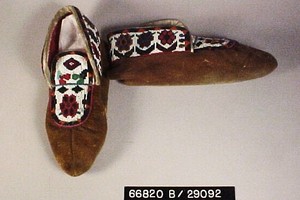
Moccasins, Canada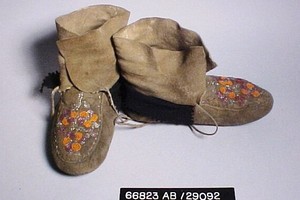
Moccasins, Canada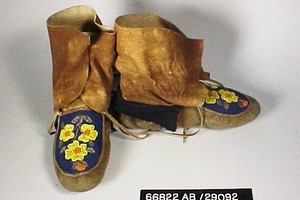
Moccasins, Canada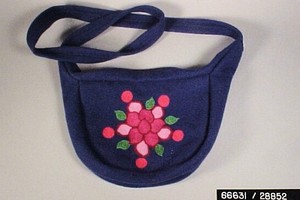
Bag, Canada
Tools and Utilitarian Items
Many of the items in this section of the Dogrib collection were used in everyday life. The wood working knife was used for things such as shaping spruce wood for the frame of a canoe, splitting spruce roots, and cutting birchbark. Caribou sinew, which was used quite often in different projects, is made from the ligaments of a caribou. It was used as thread to sew various items together such as gloves, clothing, and moccasins. Babiche is made from the skin of a caribou and is also used as thread or as a wrapping or binding material. The ice scoop and snowshoe awl are held together by babiche. The tobacco pouches are made from hide and have elaborate silk embroidery on them. "These [tobacco pouches] were made specifically to hold loose tobacco and papers to roll cigarettes. In the 1940s and 1950s, women’s dresses often had zippers in left seam under arm- between waist and armpit for fit- rather than back or front zippers, women [Dogrib] would take mission donation dresses and recycle zippers for these tobacco holders cutting ends of zippers (usually 6" long) to fit pouches" (Note from Nancy Oestreich Lurie).
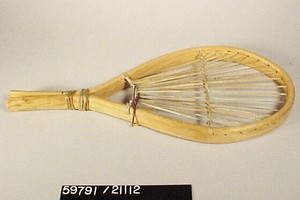
Ice Scoop, Fort Rae, Canada
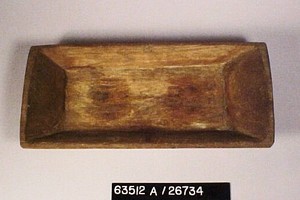
Wooden Tray, Lac la Martre, Canada
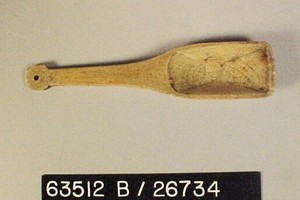
Wooden Spoon, Lac la Martre, Canada
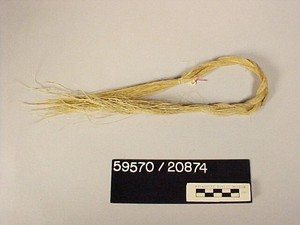
Caribou Sinew, Fort Rae, Canada
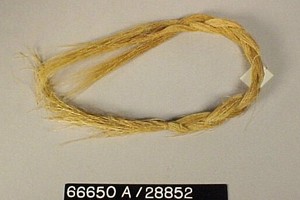
Caribou Sinew, Canada
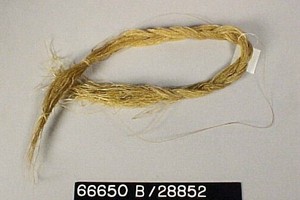
Caribou Sinew, Canada
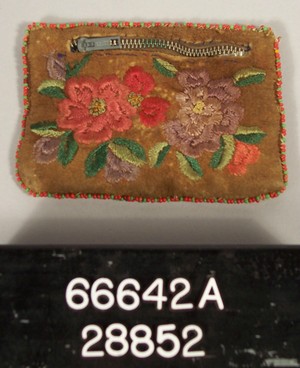
Tobacco Pouch, Northwest Territory, Canada
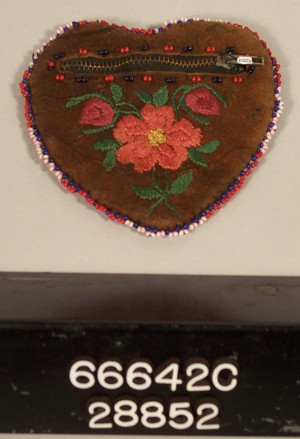
Tobacco Pouch, Northwest Territory, Canada
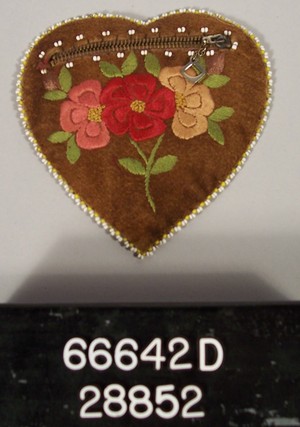
Tobacco Pouch, Northwest Territory, Canada
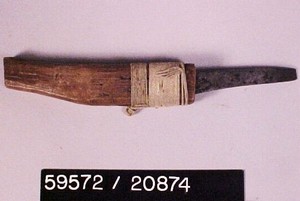
Wood Working Knife, Fort Rae, Canada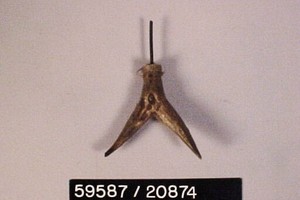
Snowshoe Awl, Fort Rae, Canada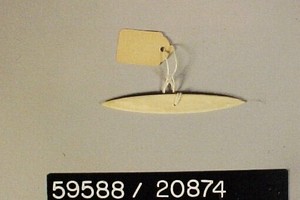
Snowshoe Needle, Fort Rae, Canada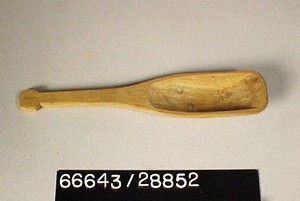
Wooden Spoon, Canada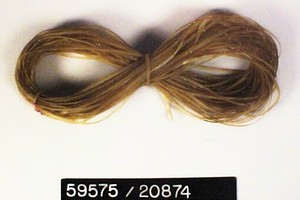
Hank of Babiche, Fort Rae, Canada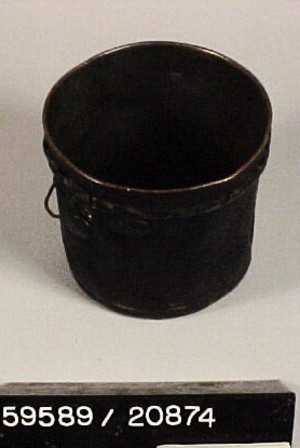
Copper Pot, Fort Rae, Canada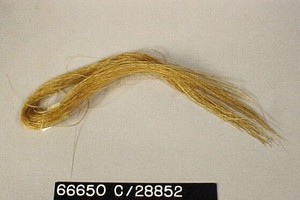
Caribou Sinew, Canada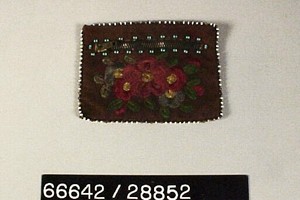
Tobacco Pouch, Northwest Territory, Canada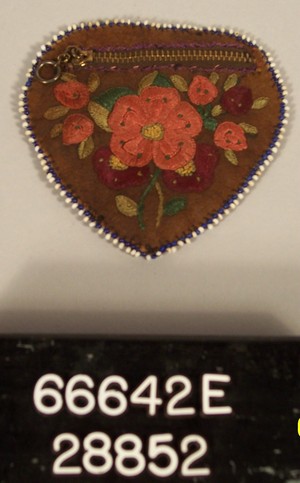
Tobacco Pouch, Northwest Territory, Canada
Snowshoes, Fort Rae, Canada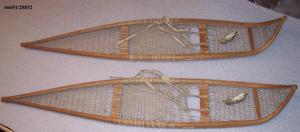
Snowshoes, Northwest Territory, Canada
Hunting and Fishing
Several items in this section of the Dogrib collection were used for fishing, such as the otter rib bone barb fishing hook, net gauge, and shuttles. Shuttles were used to weave babiche and sinew into fishing nets, and the net gage was used to determine the size of the holes in fishing nets. Other items, such as the rabbit snare, bow and arrows, and spear point, were used for hunting larger animals. The babiche hunting bags greatly assisted the Dogrib, as their sides were made of babiche/sinew, which provided a flexible bag that allowed them to carry a variety of different objects such as supplies, hunting and fishing implements, or game pieces.
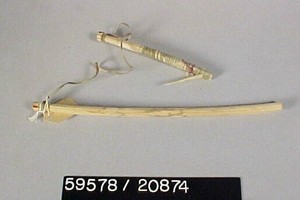
Fish Hook, Fort Rae, Canada
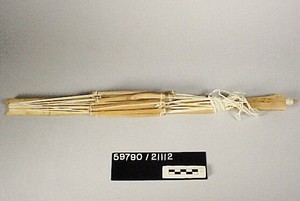
Rabbit Snare, Fort Rae, Canada
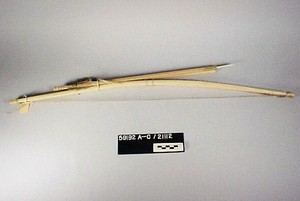
Bow and Arrows, Fort Rae, Canada
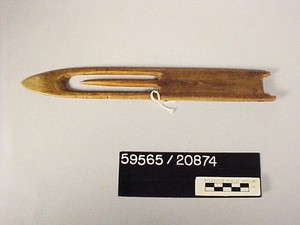
Shuttle, Fort Rae, Canada
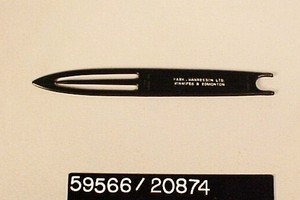
Shuttle, Fort Rae, Canada
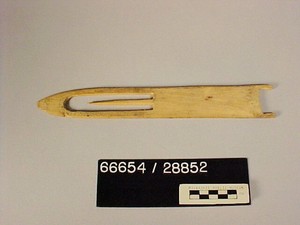
Wooden Net Shuttle, Canada
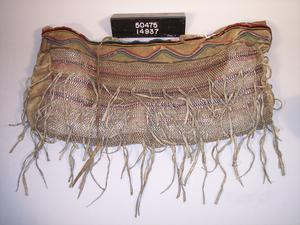
Babiche Bag, Canada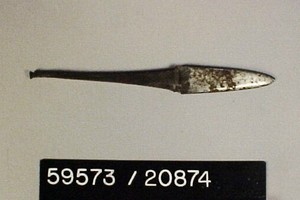
Spear Point, Fort Rae, Canada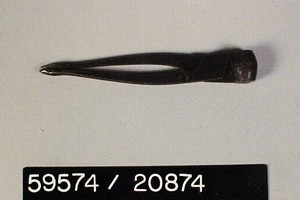
Shot Mold, Fort Rae, Canada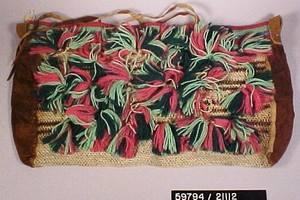
Hunting Sack, Northwest Territory, Canada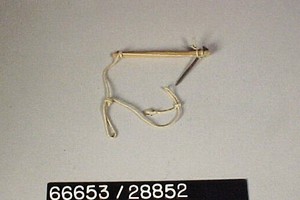
Fish Hook, Canada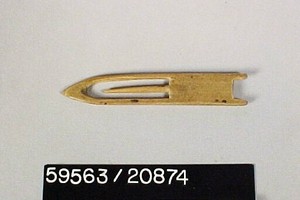
Shuttle, Fort Rae, Canada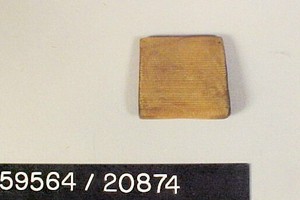
Net Gauge, Fort Rae, Canada
Hide Preparation
Several items in this section of the Dogrib collection were used to prepare animal hides for various different uses. Many of these tools were made from durable animal bones. The hind tibia and scapula of a caribou were often used as hide scrapers, as were rocks. After trade with Europeans began, metal implements were also used. These objects were used to scrape excess flesh and meat off hides so that they could be tanned, smoked, and made into various articles such as clothing and lodges.
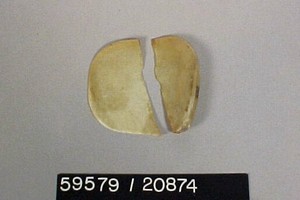
Caribou Scapula Hide Scraper, Fort Rae, Canada
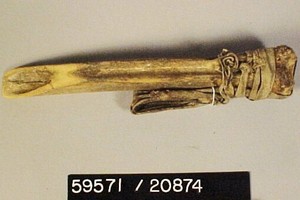
Hide Flesher, Fort Rae, Canada
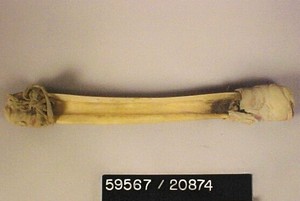
Hide Scraper, Fort Rae, Canada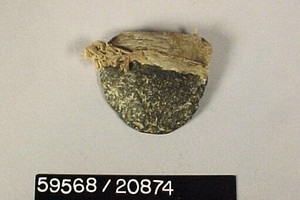
Hide Scraper, Fort Rae, Canada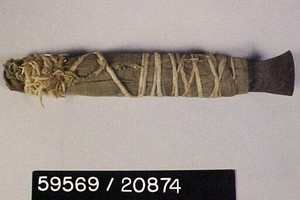
Scraper, Fort Rae, Canada
Games
Traditional games are still enjoyed by the Dogrib people today. The hand game is played to a drumbeat accompanied by chanting, during which two teams compete against each other in a hidden-object guessing game. It is quite popular during large group gatherings, such as treaty payment time and holidays. The cup and pin is another traditional game, which helped to teach skill. The player would hold the item on the opposite end of the pin then swing the other end in attempt to put the pin through the middle of the cups.

Cup and Pin Game, Fort Rae, Canada

Hand Drum for Hand Game, Fort Rae, Canada
Miniature Dog Whip, Canada

